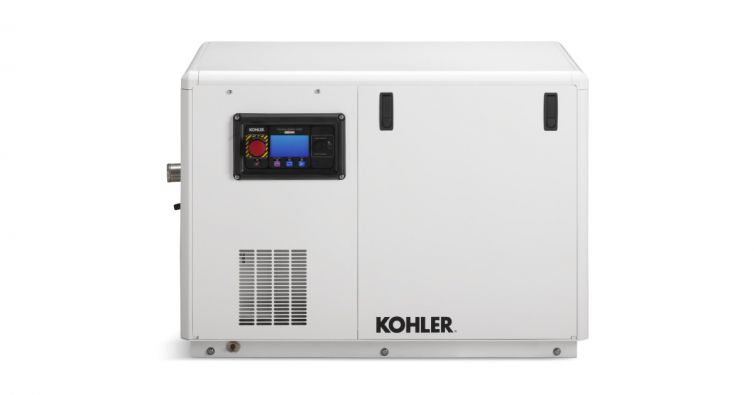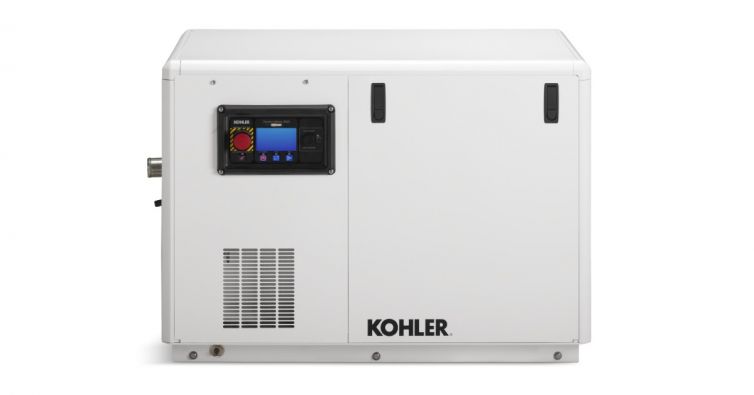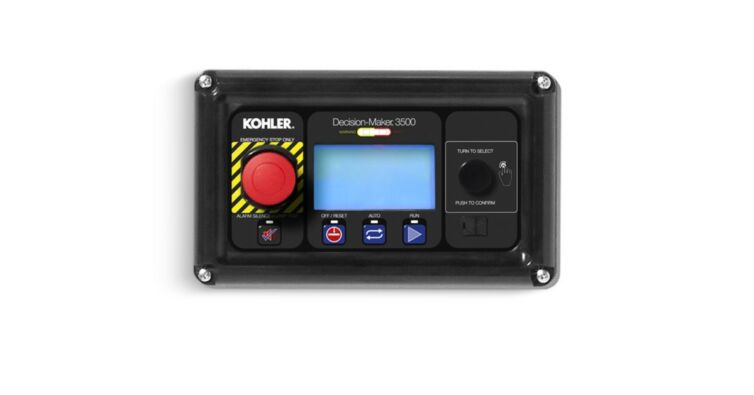Marine generators are a crucial source of power for many marine applications, including oil rigs, pleasure boats, cruise ships and industrial deep-sea vessels. However, to ensure these power marine generators run optimally, it is essential to have an efficient cooling system in place.
Marine power generators, as other power generators, are powered by a combustion engine, which produce heat as they function. To keep the generator running at peak efficiency, it needs a cooling system to dissipate this heat and maintain proper operating temperatures. In this article, we will cover everything you need to know about how the cooling system of marine generators works, the different types of cooling systems a marine generator can have, what factors can influence its efficiency, how they are maintained and more.
When a marine generator (as well as any other non-marine generator) has its cooling system working properly, it allows the entire power generating system to operate under the following conditions:
1. Better Performance:
Cooling marine generators allows them to operate at an optimal level of performance. This means that marine generators experience less wear and tear and require less repairs and maintenance.
2. Greater Durability:
Cooling marine generators increases their durability. This means that they have a longer lifespan and repair and maintenance costs are reduced significantly.
3. Greater Safety:
Cooling marine generators helps reduce the possibility of overheating. This means that they won’t explode, which improves the safety of both workers and equipment. And when it comes to safety at sea, we are talking about something very important.
4. Energy Savings:
Cooling marine generators reduces the heat generated during operation, which reduces energy consumption and saves costs.
5. Greater Flexibility:
Cooling marine generators allows generators to be efficient in different environmental conditions and adapt to different load levels. This means that they can work with greater flexibility, which improves their performance in conditions that can be changing.

The different types of cooling systems a marine generator can have.
Air-Cooled Systems.
Air-cooled systems are common in small to medium-sized generators. In these systems, air is used to transfer heat from the generator to the surrounding atmosphere. Air-cooled systems are effective at cooling the generator in normal temperature and humidity conditions. However, they may not be suitable for use in extremely hot or humid climates.
Water-Cooled Systems.
Water-cooled systems use water to transfer heat from the generator to the atmosphere. In these systems, the water is circulated through the generator and then cooled in a heat exchanger before being returned to the generator. Water-cooled systems are more efficient than air-cooled systems and can handle extreme temperatures and humidity.
Mixed-Cooling Systems.
Mixed-cooling systems use both air and water to cool the generator. Mixed-cooling systems are highly efficient and are common in large and high-capacity generators.
Oil-Cooled Systems.
Oil-cooling is less common. In these systems, oil is used to cool the generator and then cooled in a heat exchanger before being returned to the generator. Oil-cooled systems are effective at cooling the generator in extreme temperature and humidity conditions.
Liquid-Cooled Systems.
Liquid-cooled systems use coolants, such as glycol, to cool the generator. These systems are highly efficient and are common in high-capacity generators. However, liquid-cooled systems are more complex than other cooling systems and may require more maintenance. It is important to note that glycol is a very toxic substance to humans and animals, as well as being highly polluting. Spills must be cleaned up and disposed of properly when a flushing procedure is done, always following local environmental protection laws.

Parts of the cooling system of a marine generator.
The cooling system of a marine power generator is composed of several interconnected parts, all of which are vital for the proper functioning of the system. Here we will detail the most important parts:
– Liquid Coolant Radiator: Regardless of the cooling system and liquid used in the marine generator, the radiator’s function consists of lowering the temperature of the coolant coming into contact with the power generator in the cooling circuit and thus being heated. This component is formed by a series of tubes and fins that allow the coolant to flow through it, dissipating the heat by convection to the environment.
– Liquid Coolant Pump: The pump is responsible for moving the liquid coolant through the cooling system, thus ensuring that the entire system is cooled properly. When the generator is of quality the manufacturers size the pump adequately to ensure that the water flow is correct and the generator works at its optimal point.
– Thermostat: The thermostat regulates the temperature of the liquid coolant circulating through the cooling system. If the temperature is too high, the thermostat opens and allows the coolant to flow to the radiator, where it is cooled. If the temperature is too low, the thermostat closes and prevents the water from flowing to the radiator, thus keeping the correct operating temperature of the entire power generating system.
– Fan: The fan is designed to blow air over the radiator, increasing the heat transfer from the coolant to the environment. The fan turns on automatically when the coolant temperature is too high, to ensure it is cooled properly and thus maintain the optimal operating temperature of the power generating system.
– Oil Radiator: In addition to the liquid coolant radiator, the power generator may also have an oil radiator, which is responsible for cooling the engine oil of the power generator. The engine oil circulates through this radiator, dissipating the heat by convection, in the same way as the coolant does.
– Fresh Water Pump: Depending on the system, the marine generator may have a fresh water pump responsible for moving fresh water through the cooling circuit of the generator’s housing. This circuit is separate from the liquid coolant cooling circuit and is usually used to cool the electrical parts of the power generator.
– Heat Exchanger: It is a device responsible for transferring heat from a cooler liquid to a hotter liquid. This is achieved through a metal plate with slots, allowing the cold liquid to flow through the plate and the hot liquid to move to the other side. This reduces the temperature of the hot liquid, which in turn allows the generator to operate more efficiently.
Recommendations for proper maintenance of marine power generators cooling systems
It is essential that the cooling systems of marine power generators are properly maintained to ensure optimal performance. Boat and vessel owners should follow the maintenance procedures recommended by the manufacturers to ensure the integrity of the cooling systems.
Here are some tips:
1. Make sure the cooling liquid is at the correct temperature recommended in the user manual.
2. Regularly check the cooling liquid levels and filters to make sure they are not obstructed.
3. Inspect the cooling system both in its components and in the connecting hoses for possible leaks or breakdowns.
4. Make sure the system pressure is at the appropriate levels recommended in the manufacturer’s manual.
5. Perform a periodic cleaning of the cooling system components and of the liquid found in the system (Flushing). If it is a generator that uses Glycol, be sure to take into account the country’s environmental protection regulations where your boat is located. Take precautions as it is a very polluting liquid for humans and animals.
6. Inspect the system’s tubes and connecting hoses for cracks, deformations or damages.
7. Carry out a complete diagnosis to detect possible problems following the test protocols recommended by the manufacturer.
8. Make sure all the moving parts of the system are well lubricated.
9. Check that the cooling system has the appropriate levels of coolant.
10. Carry out preventive maintenance of the cooling system to detect any problem before a breakdown occurs.
Get genuine Kohler generator parts to ensure reliable performance!
Click the image below and buy by SKU number
Selecting a marine generator taking into account the cooling system it has
When choosing a marine generator for your boat always take into account the cooling system type that comes with the generator. We recommend you should consider the following main points:
- Size and capacity of your marine power generator.
- Source of cooling you will use, such as sea water or refrigerant.
- Ambient temperature in which the marine power generator will operate.
- Indirects cost of the cooling system. (Maintenance and possible repairs).
- It is important to make sure the system is reliable and easy to maintain.
- Additionally, the cooling system must be able to maintain the appropriate temperature of the marine power generator to ensure its efficiency and durability within the context it will be used the vessel.
In summary, the cooling system of a marine power generator is essential for its proper and long-lasting operation. When selecting a cooling system for your marine power generator, you should carefully consider the factors that will affect its performance and durability. By doing so, you can be sure that your marine power generator will operate efficiently and reliably for many years.
If you have any questions about what we have commented on in this article or require support, do not hesitate to contact our customer support team.
At Brags & Hayes we offer you all the necessary support to advise you on the purchase and maintain the marine generator to equip your boat.
Contact us at the phone number +1.954.657.7777, or write to us at info@bnhgenerators.com, and we will gladly help you.
In stock
For delivery in 58 weeks after placing the order
Available ex factory. (Call to confirm)
In stock
For delivery in 58 weeks after placing the order
For delivery in 58 weeks after placing the order
For delivery in 58 weeks after placing the order
In stock



















